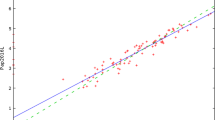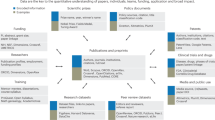Abstract
Quantitative indicators of scientific and technological activity are often of questionable validity and reliability. This is particularly true in lesser developed countries, where the lack of data gathering skills may frequently result in the development of misleading indicators. A number of manpower, education, expenditure, and publication indicators are examined for thirteen Middle Eastern countries. Reliability and validity problems are discussed for each indicator. The indicators are found to correlate with each other in reasonable ways, suggesting that despite their possible flaws, they nonetheless appear to measure scientific activity with some consistency.
Similar content being viewed by others
Notes and references
G.N. GILBERT, Measuring the Growth of Science: A Review of Indicators of Scientific Growth,Scientometrics, 1 (1978) 9–34.
C. FREEMAN,Measurement of Output of Research and Development, Unesco, Paris, 1969.
C. FREEMAN,Measurement of Scientific and Technological Activities, Unesco, Paris, 1969.
A. KAPLAN,The Conduct of Inquiry, Scranton, Pa., U.S.A., Chandler Publishing Co., 1964, p. 198–200.
SMITHSONIAN SCIENCE INFORMATION EXCHANGE,Information Services on Research in Progress: A worldwide Inventory, Washington, D. C., SSIE, 1978. (NTIS No. PB 282025)
UNESCO,National Science and Technology Policies in the Arab States, Paris, Unesco Press, 1976, p. 188–189, Translated from French by the author.
J.D. FRAME, A.N. SPRAGUE,Indicators of Scientific and Technological Efforts in the Middle East and North Africa, Washington, D.C., Computer Horizons, Inc., 1978. (Report submitted to the U.S. Agency for International Development, Purchase Order No. AID/DSAN-147-637)
See UNESCO,op. cit., note 6.. See also, UNESCO,Statistics on Scientific and Technological Manpower and Expenditure for Research and Experimental Development in Arab Countries, CASTARAB Conference, Rabat, Marocco, Unesco SC-76/Castarab 6/ Ref. 1, Paris, 30 April 1976.
Following is a sample of recent works on science and technology in the Middle East: E.B. HAAS, New Opportunities for Scientific Cooperation in the Middle East,Middle East Review, 10 (1978) 5–10; J.S. SZYLIOWICZ, Science, Technology, and Development in the Arab World,Middle East Review, 10 (1978) 24–29; A.B. ZAHLAN, Science in the Middle East,Minerva, 7 (1970) 8–35; the entire issue ofImpact of Science on Society, 26 (1976) is devoted to Arab science; NATIONAL COUNCIL FOR RESEARCH AND DEVELOPMENT,Scientific Research in Israel, 1976, Graph Press, Jerusalem, 1976.
D. de S. PRICE, Policies for Science?,Melbourne Journal of Politics, 2 (1969) 4.
R.E. EVENSON, Y. KISLEV,Agricultural Research and Productivity, New Haven, Yale University Press, 1975.
CONSEJO NACIONAL DE CIENCIA Y TECNOLOGIA,Plan Nacional Indicativo de Ciencia y Tecnologia, Mexico City, 1976.
D.E. CHUBIN, K.E. STUDER, Knowledge and Structures of Scientific Growth: Measurement of a Cancern Problem Domain,Scientometrics, 1 (1979) 171–193.
Paper under preparation by the author.
Author information
Authors and Affiliations
Rights and permissions
About this article
Cite this article
Frame, J.D. Measuring scientific activity in lesser developed countries. Scientometrics 2, 133–145 (1980). https://doi.org/10.1007/BF02279364
Received:
Revised:
Issue Date:
DOI: https://doi.org/10.1007/BF02279364




